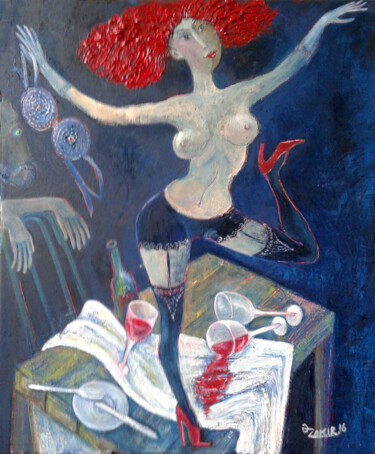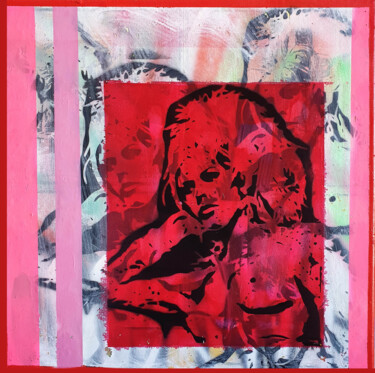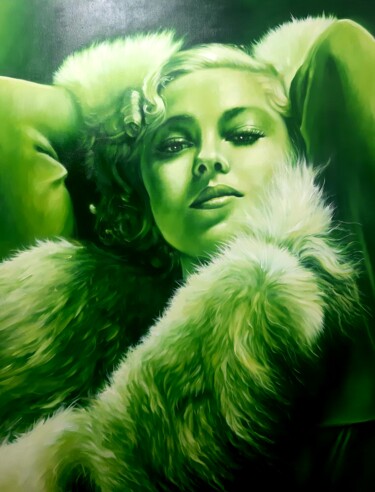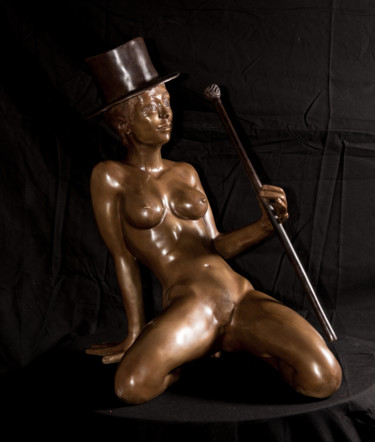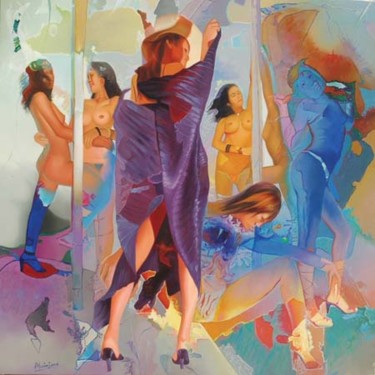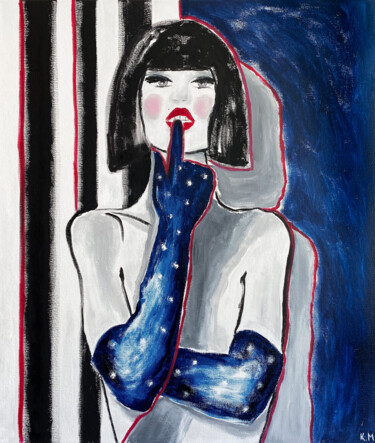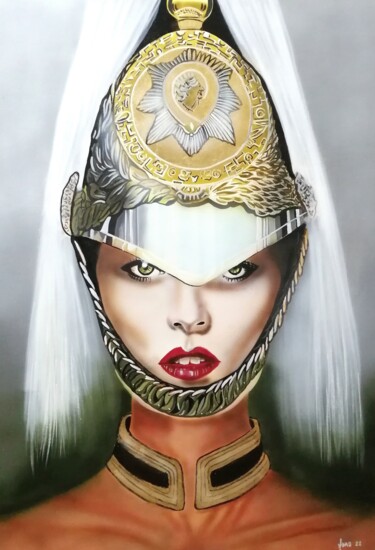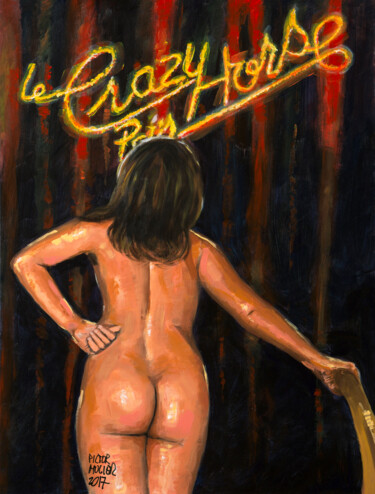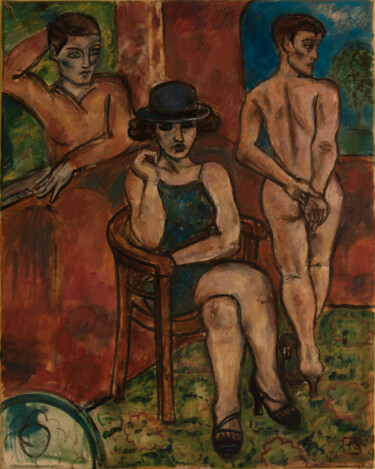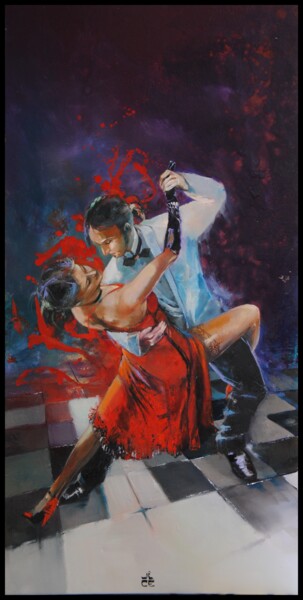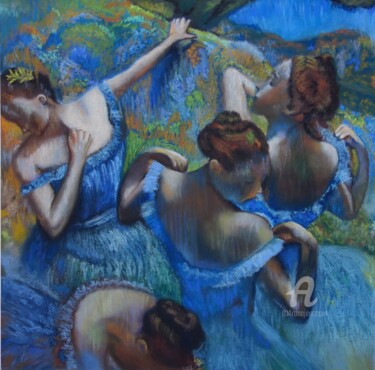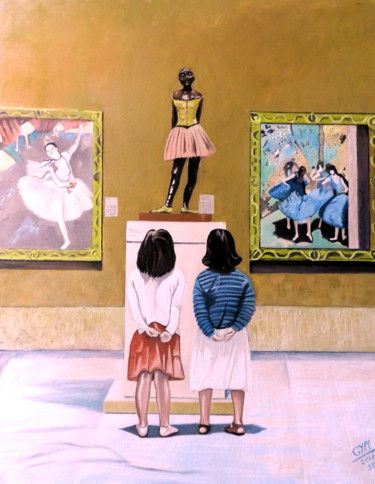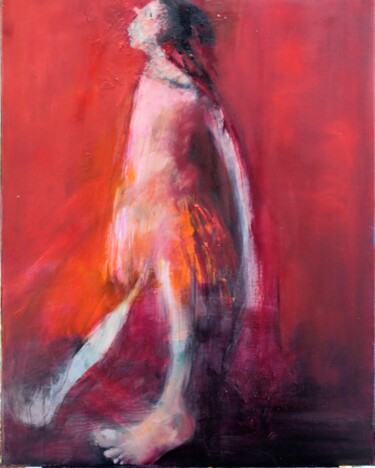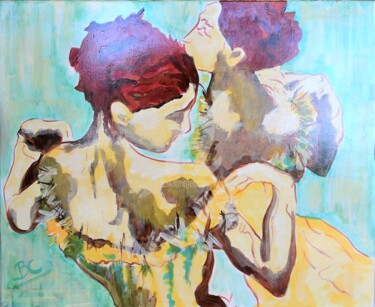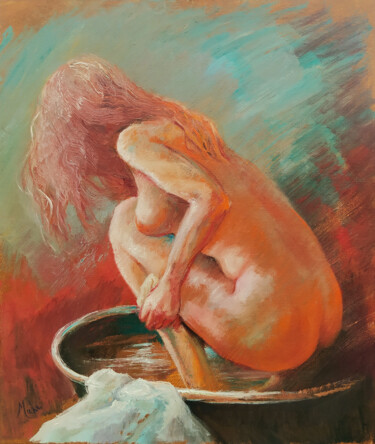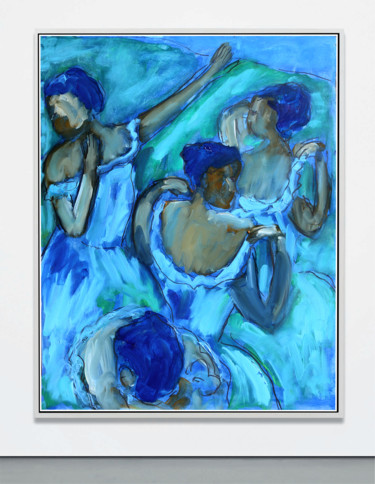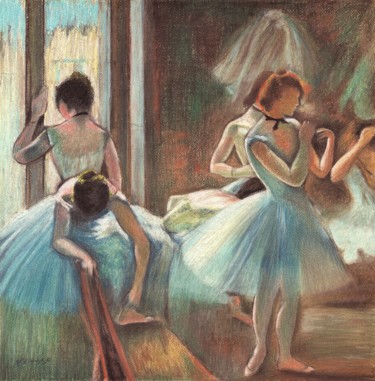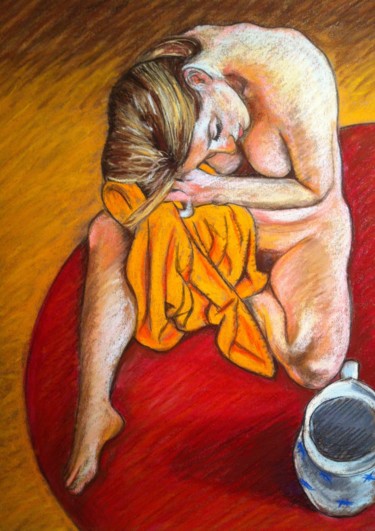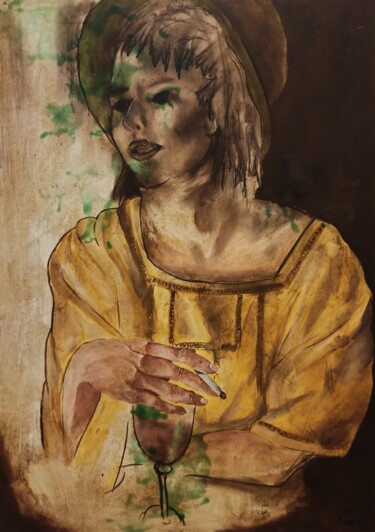 AT THE BALLET SCHOOL II (2022) Painting by Serghei Ghetiu.
AT THE BALLET SCHOOL II (2022) Painting by Serghei Ghetiu.
Having come to compulsively study the history of art, devouring books, online articles, manuals, treatises, etc., I ask myself the question of the "century": is it possible to talk about Degas without dwelling on the multi-discussed and illustrated ballerinas? Probably not, as, again, they have found their place within the narrative, which, though a marginal way, highlights their iconic recurrence and recognizability, presenting them, once again, as an indisputable manifesto of the French artist's work. Nevertheless, I have nevertheless tried to dwell on less "exploited" subjects, which I wanted to place in a concise art historical context, aimed at illustrating their evolution over the centuries. In order to pursue my goal, I started by taking a closer look at the "less popular" canvas titled The Bellelli Family (1858 - 1860), a work, which, conceived in Florence but finished in Paris, immortalizes Laurie de Gas, that is, the artist's paternal aunt, who had the opportunity to host the painter during his formative trip to Italy. In fact, it was precisely the latter woman who resided in the aforementioned Tuscan capital, a place where she was united in marriage to Gennaro Bellelli, a man by whom she had two daughters, Giovanna and Giulia. Speaking briefly of the masterpiece, inside a room furnished with sobriety and elegance, in which the sanguine portrait of Laurie's paternal grandfather stands out on the wall, we find the entire Bellelli family posing with such a naturalness and carelessness that they seem almost unaware of the artist's work. This composition is not totally causal, however, as it has been cleverly studied by the painter in order to render certain psychological traits, fundamental to say the least, of the characters. Laurie seems, with her spaced-out posture from her husband and her three-quarter stare, to manifest all her disappointment with married life, a dissatisfaction that is confirmed by her husband, who even sits with his back turned away from the family. About the daughters, however, they seem distant and estranged amid the conflicting dynamics manifested by their parents. Such interest in the inner world, aimed at animating the effigies, finds its counterpart in the higher and earlier tradition of family portraits in an interior, at the time, well exemplified by Goya's earlier work, summarized in the well-known painting of The Family of Charles IV, oil on canvas of about 1801 in which the Spanish master portrayed the members of the Spanish court with a crude and realistic cut, that is, without idealizing their physiognomies, which are instead enriched by a clear psychological characterization, aimed at "deforming" the faces into "grotesque" expressions. In this context, it is worth pointing out how even the older Family and Court of Ludovico Gonzaga, a fresco by Andrea Mantegna datable between 1465 and 1474, depicts other standing or seated figures, which, showing no intimacy between them, distance themselves from the greater emotional involvement found in in Michelangelo's Tondo doni (c. 1506) and, later, Leonetto Cappiello's The Cappiello Family (1909) or Egon Schiele's The Family (1918).
 SPACO DEGAS DANCE (2022) Painting by Spaco.
SPACO DEGAS DANCE (2022) Painting by Spaco.
 Edgar Degas, The Bellelli Family, 1858-67. Oil on canvas, 200 x 250. Paris, Musée d'Orsay.
Edgar Degas, The Bellelli Family, 1858-67. Oil on canvas, 200 x 250. Paris, Musée d'Orsay.
Another, unfortunately unfortunate theme emerges, however, from an analysis of The Rape (ca. 1868), an oil on canvas in which Degas presents a woman in petticoats, who, seated on a chair and hunched over herself, seems to assume an attitude of helplessness, humiliation and fragility, reinforced by the unassuring presence of a man, who observes her with a cold, raw gaze, while she keeps her hands in her pockets and her legs apart. In fact, this masterpiece, originally titled The Interior by the artist, represents a summary of the relationship forged by the French master with the study of night light, which he used to capture through the exaltation of the faint light of twilight, candles or lamps. Returning instead to the more gory subject matter, namely that apropos violence against women, a careful study of art history reveals the recurrence of such brutal subject matter, found in the earliest paintings of Titian's Miracle of the Jealous Husband (1511), Correggio's Danae (c. 1501) and Tintoretto's Susanna and the Old Men (c. 1557). Regarding this last oil on canvas, the Venetian master wanted to immortalize in it one of the protagonists of the Book of Daniel, namely Susanna, who, completely naked inside her husband's garden, is preparing for bathing, while she tergiversates a moment in looking at herself in the mirror. Added to this languid figure are those of two lustful old men, one of whom, cannot take his eyes off the surface of the water placed at the end of the maiden's body, on which, most likely, the most intimate part of her physicality is being reflected. Such the biblical story tells how these vigilantes purposely hid in her husband's garden in order to blackmail the woman: either she will agree to do what they want, or they will say that they have discovered her with a lover. The episode, which continues in the Book of Daniel, brings us to the history of contemporary art, which, too, has not shied away from denouncing the abuse women have suffered from the male gender. Examples of what has just been stated are, among many works, Valier Export's Tap and touch cinema (1968-1971), Nan one month after being battered (1984) by Nan Goldin, and Yoko Ono's Cut piece (1964).
 WOMAN AT THE TUB (2022) Painting by Isabel Mahe.
WOMAN AT THE TUB (2022) Painting by Isabel Mahe.
 Edgar Degas, Woman combing her hair, 1887-90. Pastel on paper applied to cardboard, 82 x 57 cm. Paris: Musée d'Orsay.
Edgar Degas, Woman combing her hair, 1887-90. Pastel on paper applied to cardboard, 82 x 57 cm. Paris: Musée d'Orsay.
The last topic addressed is summed up, however, in a repetitive, intimate and everyday feminine gesture, such as that of combing one's hair, which is the protagonist of Degas's masterpiece titled Woman Combing Her Hair, that is, a well-known pastel of about 1887, having as its most iconic antecedent the kindred figure immortalized by Michelangelo in the Sistine Chapel, precisely the one painted in the Lunette with Aminadab (1511-12). The protagonist of the fresco cycle in question is found in the genealogy of Christ, which, popularized at the Gospel according to Matthew, is intended to depict Aminadab, prince of the Levites, accompanied by his wife. Speaking instead of Degas' more classic paintings, they will be analyzed through comparison with the more contemporary remakes, made by some of Artmajeur's artists, such as, for example: Jean Mirre, Angelika Poels and Tatiana Le Metayer.
 ABSINTHE AFTER DEGAS (2022) Painting by Jean Mirre.
ABSINTHE AFTER DEGAS (2022) Painting by Jean Mirre.
Jean Mirre: Absinthe after Degas
 INSPIRED BY DEGAS (2022) Painting by Angelika Poels.
INSPIRED BY DEGAS (2022) Painting by Angelika Poels.
Angelika Poels: Inspired by Degas
Poels' acrylic, just as its title suggests, was inspired by a work by Degas, a French master who often portrayed women in their most intimate daily lives, capturing them from different and accurate perspectives composed of sinuous forms and conventional gestures. Just like the latter points of view, the composition devised by the artist in Artmajeur also shows itself for all the accuracy of its studied framing, which makes us imagine Poels intent on crouching beside the effigy, in order to capture her physicality folded in a movement, which, probably due to the intent of washing, takes place within an environment of difficult interpretation. The fact that such a vision derives from Degas is indisputable, as the acrylic seems to be a perspective sequel to The Tub (1886), re-proposing a contemplation of the human body, which, given the low framing, appears to be even more intimate, despite appearing as "obfuscated" by a purely expressionist painting technique. Regarding the 1886 masterpiece, however, it could well be summarized by some words that Degas himself noted in his writings: "Up to now the nude has been presented in poses that assumed viewing by an audience. But women are not simple people ... I show them without coquetry, in the state of washing beasts." These statements make it clear how the master eschewed official art, rejecting the idealized and aestheticized nude, to promote a femininity, which, deprived of all social coloring, presented itself in its most authentic and vulnerable moments. Looking at Inspired by Degas, after reading this quote, we realize that the intentions of the great masters of the past are still very relevant today, especially if we start thinking about all those filters, those fictions and retouches, which animate and distort the contemporary female image.
 "BLUE DANCERS", AFTER EDGAR DEGAS (2017) Painting by Tatiana Le Metayer.
"BLUE DANCERS", AFTER EDGAR DEGAS (2017) Painting by Tatiana Le Metayer.
Tatiana Le Metayer: Blue dancers, after Edgar Degas
The Artmajeur artist's pastel has clear intentions: to revive, by making it accessible to the masses, one of the greatest masterpieces in art history, such as Degas' Four Dancers in Blue, an 1897 work having the purpose of immortalizing forever the elegance and sinuosity of the movement of some maidens, who, with extreme grace and delicacy, prepare themselves in different ways in order to enter the stage. What makes this last pastel unique is the framing, which, from above, projects us directly onto the "busts" in blue of the dancers, subjects that overshadow the background executed with integrated and related chromatics designed to give ample prominence to the dominant scene. Although all of the captured context may seem very spontaneous, the artist executed several preparatory sketches, which, expertly pondered, generated a composition having the purpose of simulating being unstudied in its determined rejection of the frontal view of the image. In addition, even the movements present accurate, but disguised, theatrical cadences, aimed at staging a kind of ballet, which, punctuated by a skillful and symmetrical division of space, leaves in its lower part an unresolved question, concerning the likeness of the dancer who appears studiously captured off-screen.

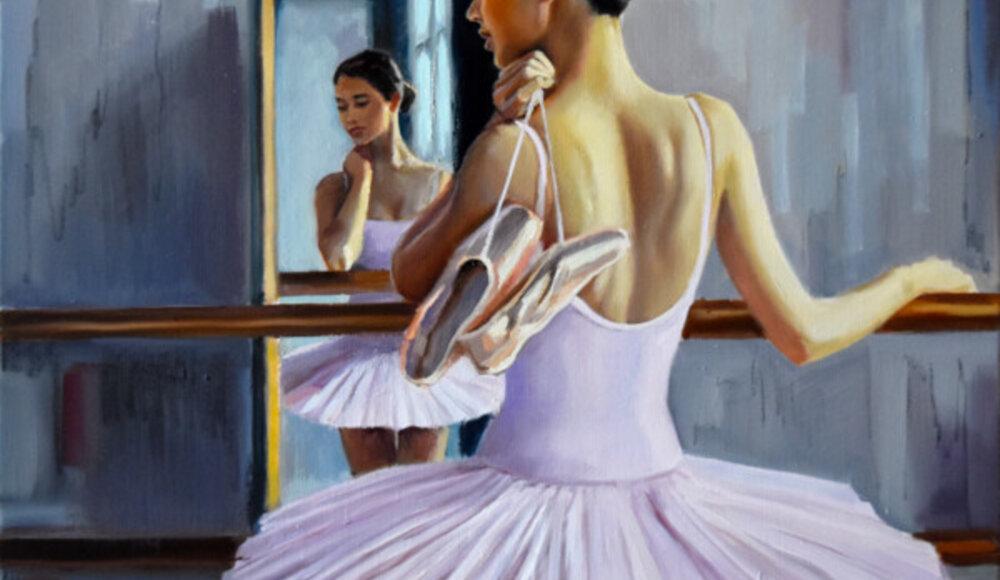
 Olimpia Gaia Martinelli
Olimpia Gaia Martinelli

